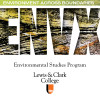Environmental Studies Blog
A Productive Listening Day in North Portland
Students from ENVS 400, Senior Seminar, reporting on their team project field day in north Portland.
Author

We started the day by walking through the area and gathering street survey responses. This was followed by an informal conversation with Kay Newell, the owner of Sunlan Lighting on North Mississippi. Familiarizing ourselves with the neighborhood, we took photographs, visited specific locations of interest, and identified the Tree of Heaven. In the afternoon, we toured the Boise-Eliot Native Grove on N. Ivy St., took a historical tour through the neighborhood with David de la Rocha, interviewed community members at the First AME Zion Church, and chatted with Charles Bedford at the Going St. Market.
In our conversations with Kay Newell and Charles Bedford, we gained insight into their personal experiences and the neighborhood’s significant spatial and demographic changes over the years.


To supplement these interviews and conversations, we conducted street surveys that questioned the locals about the Tree of Heaven. The neighborhood surveys gave us a preliminary understanding of the neighborhood’s familiarity with the Tree of Heaven. These corroborated our suspicion that the Tree of Heaven is not widely known among people who live and visit Albina.


After we visited the Grove, David de la Rocha accompanied us on our walk to the First AME Zion congregation, pointing out significant sites along the way. He discussed the construction of the I-5 freeway and Emanuel Hospital, projects that acted as a catalyst for waves of developmental displacement in Albina. He spoke on the racially motivated underpinnings of urban renewal, stating, “Blighting was not the condition of the houses but the condition [color] of the people who lived there.” Themes of institutionalized racism and gentrification surfaced repeatedly in our interviews and conversations throughout the day.

Each of us conducted a formal interview with a community member, asking questions about their personal histories, experience in the neighborhood, the Tree of Heaven, and environmental conservation. From these interviews, several themes emerged: the importance of history and community, feelings of exclusion and resilience, changing community boundaries, differing views on who is responsible for neighborhood environmental issues, and the role of government regulations and influence.
This research would not have been possible without the generosity and support of the First AME Zion, Boise Neighborhood Association, and the numerous community members who spoke with us and shared their knowledge with us.
Environmental Studies is located in room 104 of Albany Quadrangle on the Undergraduate Campus.
MSC: 62
email envs@lclark.edu
voice 503-768-7790
Symposium Advisor Jim Proctor
Environmental Studies
Lewis & Clark
615 S. Palatine Hill Road
Portland OR 97219
